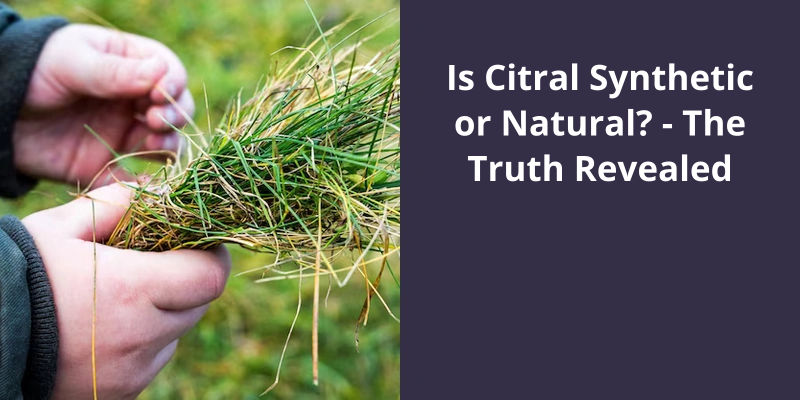Citral can be both synthetic and natural. It’s naturally found in certain essential oils, such as lemongrass, lemon myrtle, verbena, and orange, among others. However, in commercial products, citral is often synthetically produced due to cost-effectiveness. The synthetic version chemically mirrors the natural one. Regardless of the source, both natural and synthetic citrals share the same lemony fragrance, and are commonly used in air fresheners, cleaning products, and personal care items like soaps, shampoos, and perfumes.

What Is Citral Used For?
Citral, a compound found in various essential oils, is commonly used as a natural ingredient in a multitude of products. It’s strong lemon-like aroma and flavor make it an appealing addition to foods, cosmetics, and beverages. This versatile compound offers more than just sensory appeal, as it also exhibits several beneficial properties.
One of the most noteworthy characteristics of citral is it’s potential as a natural preservative. This makes citral a valuable component in preserving food products and preventing the growth of harmful microorganisms. Similarly, in the cosmetic industry, citrals antimicrobial properties aid in extending the shelf life of various personal care products.
Citral also finds application as an insect repellent due to it’s potent odor. It’s lemony scent acts as a natural deterrent to bugs and pests, making it an eco-friendly alternative to chemical-based repellents.
Apart from it’s preservative and insect-repelling properties, citral has been studied for it’s potential therapeutic effects. Research suggests that citral may possess anti-inflammatory and antioxidant properties, making it a possible candidate for the development of future pharmaceutical products. However, further studies are required to fully understand and harness the health benefits of citral.
It’s antibacterial, antifungal, and antiparasitic properties contribute to it’s suitability as a natural preservative.
Citral as a Flavoring Agent in Food and Beverages
Citral is a flavoring agent commonly used in food and beverages. It’s known for it’s citrusy aroma and taste, hence it’s popularity in products such as lemon-flavored desserts, candies, and beverages. Citral can be derived from natural sources, such as lemon, lime, or orange peel, giving it a natural and refreshing quality. However, it can also be produced synthetically in a lab to mimic the same flavor profile. Ultimately, whether Citral is synthetic or natural depends on the specific product and the manufacturer’s choice of ingredients.
Citral, a popular natural ingredient used in various industries, is composed of two aldehydes called neral and geranial. These aldehydes are classified as monoterpene monoterpene monoterpenes, which are characterized by their molecular formula C10H16. The unique combination of neral and geranial gives citral it’s distinct lemon aroma and flavor, making it a sought-after additive in food, cosmetics, and beverages.
What Is Citral Made Up Of?
Citral is a compound that’s widely used in various industries for it’s unique aroma and flavor. It’s a mixture of two aldehydes called neral and geranial, which are classified as monoterpene aldehydes. Monoterpenes are a class of terpenes that are composed of two isoprene units, with the molecular formula C10H16.
It’s passionate aroma adds a refreshing and citrusy note to these products, enhancing their overall taste and appeal.
It can be found in various beauty and personal care products, such as perfumes, soaps, and lotions. The invigorating scent of citral adds a zesty and uplifting element to these products, making them more desirable to consumers.
One of the most significant aspects of citral is that it can be obtained from natural sources, such as lemon and lemongrass essential oils. This natural sourcing makes citral a popular choice among manufacturers who prefer using natural ingredients in their products.
However, it’s important to note that citral can also be synthetically produced in laboratories. The synthetic production of citral allows for a more consistent and reliable supply, making it an attractive option for large-scale production.
In conclusion, citral is a potent biomolecule that offers a wide range of biological activities and therapeutic implications. It’s antimicrobial, antioxidant, anticancer, anti-diabetic, and anti-inflammatory properties make it a valuable compound for potential medical applications. The diverse benefits of citral highlight it’s potential as a promising ingredient in the development of new drugs and treatments.
What Are the Benefits of Citral?
Citral, a natural compound found in many essential oils, has been the subject of extensive research due to it’s numerous health benefits. One of the key advantages of citral is it’s antimicrobial properties. Studies have shown that citral can effectively inhibit the growth of various pathogenic bacteria and fungi, making it a valuable agent in the prevention and treatment of infections. Additionally, citral acts as a powerful antioxidant, helping to neutralize harmful free radicals and protect cells from oxidative damage.
In addition to it’s antimicrobial and antioxidant properties, citral has also demonstrated anticancer effects. Research has revealed that citral can inhibit the growth and spread of cancer cells, making it a promising candidate for cancer treatment. Furthermore, citral has been found to possess anti-diabetic properties, as it can help regulate blood sugar levels and improve insulin sensitivity.
Moreover, citral exhibits anti-inflammatory effects, which can help alleviate symptoms of inflammatory conditions such as arthritis and asthma.
In addition to plant oils such as lemongrass, verbena, and citronella, citral can also be extracted from myrcene, contributing to it’s natural and organic composition.
What Is the Natural Source of Citral?
Myrcene is a natural hydrocarbon found in various plants, such as hops, mangoes, and lemongrass. Through a series of chemical reactions, myrcene can be transformed into citral, making it a natural source of this compound. However, it’s important to note that citral can also be synthesized in a laboratory setting.
When it comes to the production of citral on an industrial scale, both natural and synthetic methods are utilized. The natural sources, such as lemongrass oil, are often preferred due to their higher citral content and the potential for a more sustainable production process. Distillation is typically used to extract the citral from the plant oils, ensuring it’s purity.
Isomerization of elements like geraniol or nerol can lead to the synthesis of citral. Synthetic citral is commonly used in the fragrance and flavor industries, offering a more cost-effective alternative to natural sources.
In terms of labeling, it’s crucial to differentiate between natural and synthetic citral. The International Fragrance Association (IFRA) requires manufacturers to indicate the source of citral on their product labels, ensuring transparency for consumers. Therefore, if a product contains natural citral, it should be clearly stated to allow individuals to make informed purchasing decisions.
Source: Citral
Conclusion
It’s a mixture of neral and geranial, which are both monoterpene aldehydes. It’s captivating lemon aroma and flavor have made it a popular choice among consumers. Understanding the origin and nature of citral allows us to appreciate it’s value as a natural and aromatic compound.





